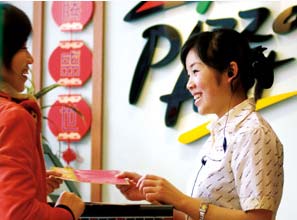Kentucky Fried Chicken (KFC) plans to build a 4.67-hectare frozen storage area in the suburbs of Lhasa to prepare for expansion into Tibet, according to Xinhua, the official press agency of the People’s Republic of China (PRC). Quoting Chen Biao, manager of the Lhasa Shenlishidai shopping center, it reported that the Louisville, Kentucky, USA-headquartered fast food chain will open its first restaurant in Tibet by the end of January 2016.
While details of Colonel Sanders’ long anticipated march into Tibet were not discussed at the recently held investor conference of KFC parent company Yum! Brands in Plano, Texas, there was plenty of talk about growth in China and around the world. As the consuming class in the PRC is expected to double from 300 million people in 2012 to more than 600 million by 2020, Yum anticipates tripling the number of its KFC, Pizza Hut and Taco Bell outlets operating in that country from 6,900 today to 20,000 in the future. Approximately 700 new units came opened for business during 2015.
CEO Greg Creed, addressing the pending spin-off of the Yum China operation, which rang up more than half of the company’s operating profit in the third quarter of 2015, stated:
“We continue to make solid progress on our planned separation into two independent, publicly-traded companies – Yum! Brands and Yum China – each with compelling growth strategies, distinct investment characteristics, and optimized capital structures. This transaction is a classic example of ‘one plus one equals more than two,’ as it will enable each company to realize its full potential and achieve greater value on a standalone basis.”
He also announced that the company intends to return up to $6.2 billion of capital to shareholders prior to the completion of the separation, which is likely to take place in late 2016.
Headquartered in Shanghai, Yum China rang up $6.9 billion in sales during 2014. That was more than revenues generated outside of the PRC, which amounted to $6.3 billion. Meanwhile, the China operation expects to record growth of 10% in 2016 and 15% in 2017.
Recent monthly results in China, however, point to a same-store year-over-year (YOY) sales decline of 3% in November (which had one less weekend than November of 2014), including a 1% dip at KFC and a 9% downturn at Pizza Hut. This followed a 9% gain over September. It is estimated that same-store sales growth for the fourth quarter will range from 0% to 4%, with KFC on the positive side and Pizza Hut on the negative side of the ledger.
 After the formal separation occurs, the newly-formed Yum China entity will be led by Micky Pant, who was named chief executive officer in August. It will be the largest franchisee under a franchise agreement, with Yum! Brands receiving a license fee of 3% for KFC, Pizza Hut and Taco Bell system sales in China. At the moment there are no Taco Bell restaurants in the PRC, but this is not expected to be the case for long, as the Tex-Mex style fast food chain is counting on significant expansion outside the USA to achieve its goal of $15 billion in global sales goal by 2022.
After the formal separation occurs, the newly-formed Yum China entity will be led by Micky Pant, who was named chief executive officer in August. It will be the largest franchisee under a franchise agreement, with Yum! Brands receiving a license fee of 3% for KFC, Pizza Hut and Taco Bell system sales in China. At the moment there are no Taco Bell restaurants in the PRC, but this is not expected to be the case for long, as the Tex-Mex style fast food chain is counting on significant expansion outside the USA to achieve its goal of $15 billion in global sales goal by 2022.
David Novak, executive chairman of Yum! Brands and regarded as the architect of its operations in China since the first KFC was established in Beijing in 1987, is especially enthusiastic about the division’s standalone status destiny.
“I had the great fortune to lead the spin-off from Pepsi in 1987, when we were considered the ugly duckling of PepsiCo. This spin-off is not an ugly duckling, but the eagle of our company,” said Novak. “We would not be the great company we are today without China. This is an offensive move. I am going to hold my Yum China stock.”
The Colonel’s on a Global Roll Roger Eaton, chief executive officer of KFC, reported that the chain that specializes in fried chicken continues to perform well in all markets. Its operations have logged six consecutive quarters in the plus column in the USA averaging a 4% growth rate, with profits exceeding $75 million. Same-store sales growth in the Australia/South Pacific market has been 7%, with profits topping $90 billion. Operations in Japan have charted 5% growth and profits exceeding $20 million.
Roger Eaton, chief executive officer of KFC, reported that the chain that specializes in fried chicken continues to perform well in all markets. Its operations have logged six consecutive quarters in the plus column in the USA averaging a 4% growth rate, with profits exceeding $75 million. Same-store sales growth in the Australia/South Pacific market has been 7%, with profits topping $90 billion. Operations in Japan have charted 5% growth and profits exceeding $20 million.
Eaton said that there is “huge potential in emerging markets,” where headwinds are being overcome. Same-store sales growth and YOY sales respectively advanced 14% and 43% in Russia (a country with promise for 1,000 more units); 6% and 16% in Brazil (another nation with potential for over 1,000 additional units); and 11% and 23% in Turkey (where 400-plus unit growth is probable).
“In the future, we expect to be beating McDonald’s in both Russia and India,” said the chief executive. In addition to China, where KFC’s 4,400 store count currently outstrips McDonald’s by more than two to one, its lead over the burger baron in six key emerging markets was posted as follows by Eaton: South Africa, 771 to 215; Malaysia, 608 to 267; Indonesia, 492 to 158; Thailand, 488 to 208; Egypt, 146 to 84; Vietnam, 137 to 3.
Worldwide, McDonald’s remains the No. 1 quick service restaurant brand with 36,000 stores, compared to approximately 15,000 locations flying the KFC banner.

Yum Brands’ ranks as the global leader in the chicken, pizza and Tex-Mex style burrito and taco fast food categories with 41,000 restaurants in over 125 countries. International sales totaled $12.9 billion in 2014, compared to $27.4 billion for McDonald’s.
Easton went on to say that among 12 of KFC’s top emerging markets the population is approximately three billion. However, its restaurant penetration currently stands at only one unit per million people compared with 14 outlets per million in the United States. Combined Yum! Brands unit penetration is 57 units per million persons in the USA and five per million in China.
The Nigerian market is particularly attractive in West Africa for Yum! Brands. Situated in West Africa, and home to the continent biggest economy (estimated at $479 billion) and largest population (about 171 million), it presently operates only 27 restaurants in the oil- and gas-rich nation with a rising consumer class.
“We believe we can achieve growth of 900% there in the future,” said Yum! Brands CEO Creed. – Reported by John Saulnier





